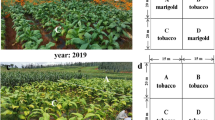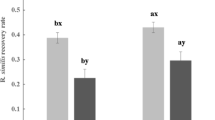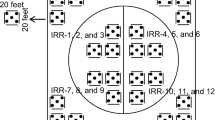Abstract
Soil properties, microbial communities, and enzyme activities were studied in soil planted with transgenic or nontransgenic papaya under field conditions. The transgenic papaya contained a replicase (RP) mutant gene of the papaya ringspot virus (PRSV), which conferred resistance to the virus, the neomycin phosphotransferase II (NPT II) marker gene, which conferred Km resistance, and a cauliflower mosaic virus 35S promoter (CaMV 35S). There were significant differences (P < 0.05) in the total number of colony forming units (CFUs) of bacteria, actinomycetes, and fungi between soils planted with RP-transgenic and nontransgenic plants; total CFUs of bacteria, actinomycetes, and fungi in soil planted with transgenic papaya were significantly higher by 0.43, 0.80, and 0.46 times, respectively. Significantly higher (P < 0.05) CFUs of bacteria, actinomycetes, and fungi resistant to kanamycin (Km) were present in soils planted with the transgenic papaya than in those planted with nontransgenic papaya. Resistance quotients (CFU in the presence of a chemical relative to that without) of Km-resistant bacteria, actinomycetes and fungi were higher in soil planted with transgenic papaya, and the resistance quotients of Km-resistant bacteria, actinomycetes, and fungi in soils planted with transgenic papaya increased statistically significantly (P<0.05) from 1.5 to 2.5, from 1.2 to 2.6, and from 0.9 to 2.8 times, respectively. Soils planted with transgenic papaya had significantly higher enzyme activities of arylsulfatases (+5.4 times), alkaline phosphatases (+0.5 time), invertase (+0.5 time) and phosphodiesterases (+0.2 time), but lower enzyme activities of proteases (−2.1 times), polyphenol oxidases (−1.4 times), urease (−0.2 time) than the soils planted with nontransgenic papaya. Our results suggest that transgenic papaya could alter chemical properties, enzyme activities, and microbial communities in soil.
Similar content being viewed by others
References
Acosta-Martinez V, Zobeck T (2004) Enzyme activities and arylsulfatase protein in dust generated under laboratory conditions from agricultural soils. J Environ Qual 33:1589–1599
Badosa E, Moreno C, Montesinos E (2004) Lack of detection of ampicillin resistance gene transfer from Bt176 transgenic corn to culturable bacteria under field conditions. FEMS Microbiol Ecol 48:169–178
Bandick AK, Dick RP (1999) Field management effects on soil enzyme activities. Soil Biol Biochem 31: 1471–1479
Bernfeld P (1995) Amylases α and β. Methods Enzymol 1:149–158
Bertolla F, Simonet P (1999) Horizontal gene transfers in the environment: natural as a putative process for gene transfers between transgenic plants and microorganisms. Res Microbiol 150:375–384
Boerner REJ, Brinkman JA (2003) Fire frequency and soil enzyme activity in southern Ohio oak-hickory forests. Appl Soil Ecol 23:137–146
Bremner JM (1996) Nitrogen—total. In: Sparks DL (Ed.) Methods of soil analysis. Part 3—Chemical methods. SSSA and ASA, Madison pp 1085–1121
Callaghan MO, Glare TR (2001) Impacts of transgenic plants and microorganisms on soil biota. NZ Plant Protection 54:105–110
Chance B, Maehly SK (1955) Assay of catalase and peroxidases. Methods Enzymol 2:764–775
Chen G, Ye CM, Huang JC, Li BJ (1998) Study on transgenic papaya plants with replicase gene of papaya ringspot virus. Hereditas (Beijing) 20:9–11
Cook RJ (1999) Science-based risk assessment for the approval and use of plants in agricultural and other environments. In: Persley GJ, Lantin MM (eds) Agricultural biotechnology and the poor. Consultative Group on International Agricultural Research, Washington, DC. pp 123–130
Cowgill SE, Wright C, Atkinson HJ (2002) Transgenic potatoes with enhanced levels of nematode resistance do not have altered susceptibility to nontarget aphids. Mol Ecol 11:821–827
Davies J (1994) Inactivation of antibiotics and the dissemination of resistance genes. Science 264:375–382
Deng SP, Tabatabai MA (1994) Cellulase activity of soils. Soil Biol Biochem 26:1347–1354
de Vries J, Meier P, Wackernagel W (2001) The natural transformation of Pseudomonas stutzeri and Acinetobacter sp. by kanamycin resistance genes (nptII) present in plasmids and the genome of transgenic plants depends on homologous sequences in the recipient cells. FEMS Microbiol Lett 195:211–215
Donegan KK, Seidler RJ, Fieland VJ, Schaller DL, Palm CJ, Ganio LM, Cardwell DM, Steinberger Y (1997) Decomposition of genetically engineered tobacco under field conditions: persistence of the proteinase inhibitor I product and effects on soil microbial respiration and protozoa, nematode and microarthropod populations. J Appl Ecol 34:767–777
Donegan KK, Seidler RJ, Doyle JD, Porteous LA, Digiovanni G, Widmer F, Watrud LS (1999) A field study with genetically engineered alfalfa inoculated with recombinant Sinorhizobium meliloti: effects on the soil ecosystem. J Appl Ecol 36:920–936
Dunfield KE, Germida JJ (2004) Impact of genetically modified crops on soil- and plant-associated microbial communities. J Environ Qual 33:806–815
Edwards CA (2002) Assessing the effects of environmental pollutants on soil organisms, communities, processes and ecosystems. Eur J Soil Biol 38:225–231
Escher N, Kach B, Nentwig W (2000) Decomposition of transgenic Bacillus thuringiensis maize by microorganisms and woodlice Porcello scaber (Crustacea: Isopoda). Basic Appl Entomol 1:161–169
Falih AMK, Wainwright M (1996) Microbial and enzyme activity in soils amended with a natural source of easily available carbon. Biol Fert Soils 21:177–183
Flores S, Saxena D, Stotzky G (2005) Transgenic Bt plants decompose less in soil than non-Bt plants. Soil Biol Biochem 37:1073–1082
Gebhard F, Smalla K (1999) Monitoring field releases of genetically modified sugar beets for persistence of transgenic plant DNA and horizontal gene transfer. FEMS Microbiol Ecol 28:261–272
Gonsalves D, Ishii M (1980) Purification and serology of papaya ringspot virus. Phytopathology 70:1028–1032
Grayston SJ, Wang SQ, Campbell CD, Edwards AC (1998) Selective influence of plant species on microbial diversity in the rhizosphere. Soil Biol Biochem 30:369–378
Griffiths BS, Geoghegan IE, Robertson JR (2000) Testing genetically engineered potato, producing the lectins GNA and Con A, on non-target soil organisms and processes. J Appl Ecol 37:159–170
Grimshaw HM, Allen SE, Parkinson JA (1989) Nutrient elements. In: Allen SE (Ed). Chemical analysis of ecological materials. 2nd edn., Blackwell Scientific Publications, Oxford, pp 81–159
Hattori T, Mitsui H, Haga H, Wakao N, Shikano S, Gorlach K, Kasahara Y, El-Beltagy A, Hattori R (1997) Advances in soil microbial ecology and the biodiversity. Antonie van Leeuwenhoek 72:21–28
Heineman JA, Traavik T (2004) Problems in monitoring horizontal gene transfer in field trials of transgenic plants. Nature Biotech 22:1105–1109
Hopkins DW, Webster EA, Chudek JA, Halpin C (2001) Decomposition in soil of tobacco plants with genetic modifications to lignin biosynthesis. Soil Biol Biochem 33:1455–1462
Information Systems for Biotechnology (2006) Status of all field test permits 1987-present. Virginia Tech., Blacksburg, VA. http://www.isb.vt.edu/cfdocs/ISBtables.cfm
James C (2004) Preview: Global Review of Commercialized Biotech/GM Crops: 2004. ISAAA Briefs No. 32. ISAAA, Ithaca, NY
Johnson JL, Temple KL (1964) Some variables affecting the measurement of ‘catalase activity’ in soil. Soil Sci Soc Am Proc 28:207–209
Karina A, Jorge AP, Mercedes H, Cira D, Juan G, Elda R (2004) Evaluation of volatiles from ripening papaya (Carica papaya L., var. Maradol roja). Food Chem 86:127–130
Kennedy AC, Smith KL (1995) Soil microbial diversity and the sustainability of agricultural soils. Plant Soil 170:75–86
Ladd JN, Butler JHA (1972) Short-term assays of soil proteolytic enzyme activities using proteins and dipeptide derivatives as substrates. Soil Biol Biochem 4:19–30
Macalady JL, McMillan AMS, Dickens AF, Tyler SC, Scow KM (2002) Population dynamics of type I and II methanotrophic bacteria in rice soils. Environ Microbiol 4:148–157
Mamilov AS, Byzov BA, Zvyagintsev DG, Dilly OM (2001) Predation on fungal and bacterial biomass in␣a soddy-podzolic soil amended with starch, wheat␣straw and alfalfa meal. Appl Soil Ecol 16:131–139
McGregor AN, Turner MA (2000) Soil effects of transgenic agriculture: biological processes and ecological consequences. NZ Soil News 48(6):166–169
Naseby DC, Lynch JM (1998) Impact of wild-type and genetically modified Pseudomonas fluorescens on soil enzyme activities and microbial population structure in the rhizosphere of pea. Mol Ecol 7:617–625
National Research Council (2000) Genetically modified pest-protected plants: science and regulation committee on genetically modified pest-protected plants. National Academy Press, Washington, DC
Nielsen KM, Gebhard F, Smalla K, Bones AM, van Elsas JD (1997) Evaluation of possible horizontal gene transfer from transgenic plants to the soil bacterium Acinetobacter calcoaceticus BD413. Theor Appl Genet 95:815–821
Nielsen KM, van Elsas JD, Smalla K (2000) Transformation of Acinetobacter sp. strain BD413 (pFG4-nptII) with transgenic plant DNA in soil microcosms and effects of kanamycin on selection of transformants. Appl Environ Microbiol 66:1237–1242
Ross DJ (1970) Effects of storage on dehydrogenase activities of soils. Soil Biol Biochem 2:55–61
Rowell DL (1994) Soil science: methods and application. Longman Group UK Ltd., London
Saxena D, Flores S, Stotzky G (2002) Bt toxin is released in root exudates from 12 transgenic corn hybrids representing three transformation events. Soil Biol Biochem 34:133–137
Saxena D, Stotzky G (2000) Larvicidal toxin from Bacillus thuringiensis is released from roots of transgenic Bt corn in vitro and in situ. FEMS Microbiol Ecol 33:35–39
Saxena D, Stotzky G (2001a) Bacillus thuringiensis (Bt) toxin released from root exudates and biomass of Bt corn has no apparent effect on earthworms, nematodes, protozoa, bacteria, and fungi in soil. Soil Biol Biochem 33:1225–1230
Saxena D, Stotzky G (2001b) Bt corn has a higher lignin content than non-Bt corn. Am J Bot 88:1702–1706
Schmalenberger A, Tebbe CC (2002) Bacterial community composition in the rhizosphere of a transgenic, herbicide-resistant maize (Zea mays) and comparison to its non-transgenic cultivar Bosphore. FEMS Microbiol Ecol 40:29–37
Schluter K, Futterer J, Potrykus I (1995) Horizontal gene transfer from a transgenic potato line to a bacterial pathogen (Erwinia chrysanthemi) occurs, if at all, at an extremely low frequency. Biotechnology 13: 1094–1098
Sengeløv G, Kristensen KJ, Sørensen AH, Kroer N, Sørensen SJ (2001) Effect of genomic location on horizontal transfer of a recombinant gene cassette between Pseudomonas strains in the rhizosphere and spermosphere of barley seedlings. Cur Microbiol 42:160–167
Sessitsch A, Gyamfi S, Tscherko D, Gerzabeki MH, Kandeler E (2004) Activity of microorganism in the rhizosphere of herbicide treated and untreated transgenic glufosinate-tolerant and wildtype oilseed rape grown in containment. Plant Soil 266:105–116
Siciliano SD, Germida JJ (1999) Taxonomic diversity of bacteria associated with the roots of field-grown transgenic Brassica napus cv. Quest, compared to the non-transgenic B. napus cv. Excel and B. rapa cv. Parkland. FEMS Microbiol Ecol 29:263–272
Smalla K, Gebhard F, van Elsas JD, Matzk A, Schiemann J (1994) Bacterial communities influenced by transgenic plants. Proceedings of the 3rd International Symposium on the Biosafety Results of Field Tests of Genetically Modified Plants and Microorganisms. DD Jones (ed), pp 157–166. University of California, Oakland, CA, USA
Stotzky G (2000) Persistence and biological activity in soil of insecticidal proteins from Bacillus thuringiensis and of bacterial DNA bound on clays and humic acids. J␣Environ Qual 29:691–705
Stotzky G (2004) Persistence and biological activity in soil of the insecticidal proteins from Bacillus thuringiensis, especially from transgenic plants. Plant Soil 266:77–89
Suwenza L, Manshardt RH, Fitch MM, Slighom JL, Sanford JC, Gonsalves D (1997) Pathogen-derived resistance provides papaya with effective protection against papaya ringspot virus. Mol Breed 3:161–168
Tabatabai MA (1994) Soil enzymes. In: Weaver RW, Angle S, Bottomley P, Bezdicek D, Smith S, Tabatabai A, Wollum A (Eds). Methods of soil analysis Part 2. Microbiological and biochemical properties. Soil Science Society of America, Madison. pp 797–798
Tepfer D, Garcia-Gonzales R, Mansouri H, Seruga M, Message B, Leach F, Perica MC (2003) Homology-dependent DNA transfer from plants to a soil bacterium under laboratory conditions: implications in evolution and horizontal gene transfer. Transgenic Res 12:425–437
Wei XD, Ye CM, Lu ZJ, Lan CY (2005) Analyses of viral resistance and fruit quality for T4 generation of transgenic papaya. Acta Ecol Sinica 12:3301–3306
Wu WX, Ye QF, Min H, Duan XJ, Jin WM (2004) Bt-transgenic rice straw affects the culturable microbiota and dehydrogenase and phosphatase activities in a flooded paddy soil. Soil Biol Biochem 36:289–295
Ye CM, Wei XD, Chen DH, Lan CY, Chu LM (2003) Analyses of virus resistance and transgenes for transgenic papaya. Hereditas (Beijing) 25(2):181–184
Ye WQ, Zhang WQ, Zhou PX, Xie JZ, Zhang YL 1983. Experimental methods of soil microbes. Science Press (in Chinese)
Acknowledgements
This work was financially supported by the Doctoral Program of Higher Education of China (No. 20020558044), the Key Program of the Ministry of Education of China (No. 031280), the Guangzhou Municipal Environmental Protection Bureau (No. 2001-17) and the Guangzhou Municipal Key Research (2002E2-E0182).
Author information
Authors and Affiliations
Corresponding author
Rights and permissions
About this article
Cite this article
Wei, X.D., Zou, H.L., Chu, L.M. et al. Field Released Transgenic Papaya Affects Microbial Communities and Enzyme Activities in Soil. Plant Soil 285, 347–358 (2006). https://doi.org/10.1007/s11104-006-9020-8
Received:
Accepted:
Published:
Issue Date:
DOI: https://doi.org/10.1007/s11104-006-9020-8




